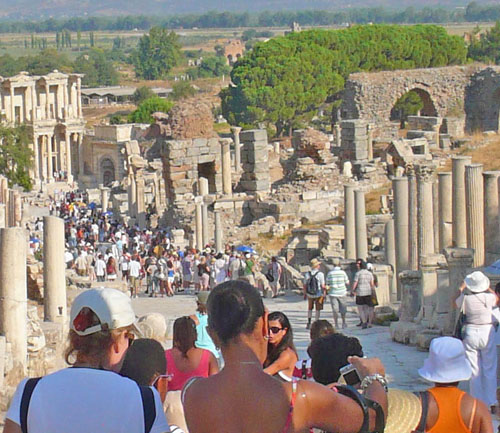Name an ancient Roman city that was wiped out by a natural disaster. Pompeii most likely comes to mind, but there's another, lesser known Roman city emerging out of the rubble on the Turkish coast that could upstage Pompeii on the disaster scale.

It's named Ephesus, and while only a small portion of it has been excavated, archaeologists say it may have been the Roman empire's second largest city, topped only by Rome itself. Ephesus' end came from the double-whammy of a massive earthquake in 614 coupled with a huge buildup of silt in its harbor -- so much that the shoreline edged 10 or so miles out to sea, putting the city that far inland.
With the loss of the harbor, traders working the coast of Asia Minor moved elsewhere, which pretty much put Ephesus out of business.
Founded as an Ionian colony in the 10th century B.C., the city fell to the arrows, swords, scimitars and cannons of a succession of conquerors over the years, notably those of the Greeks, Persians, Egyptians, Romans, Goths and Christians.
Ephesus' main eye-popper under the early Grecian banners was the immense Temple of Artemis (the supergod Apollo's twin sister), said to be three times the size of the Parthenon in Athens. It went down in the history books as one of the Seven Wonders of the Ancient World.
At its peak under Roman rule in the 1st and 2nd centuries A.D., the city probably spread out over a square mile and was home to perhaps a half-million people. It's not hard to imagine thousands of them cheering for their favorite gladiators from the stone tiers of the town's 20-story-high outdoor theater.
You can almost see scholars, lawyers and politicians pouring through the 12,000 scrolls in the landmark Library of Celsus. Elsewhere, you might run across commoners taking in plays and concerts at the Odeon theater or hanging out at the city's dozens of temples and shrines.
After a long day of scroll-reading, some scholars may have slipped away to the town brothel through a hidden tunnel near the library. After that, they may have gone home to the Beverly Hills-like neighborhoods overlooking the city, or visited Ephesus' answer to the Rodeo Drive upscale shopping mecca.
It's estimated that Ephesus' visitor count comes close to a million a year, many of them from cruise ships docked at the Turkish port of Kusadasi about 15 miles away. It's not unusual to see long caravans of 60-passenger buses snaking through the hills to the historic site.
After three or so hours of soaking up the culture of ancient Rome, the tourists arrive back in Kusadasi for a few hours of getting soaked in the city's jam-packed bazaars. On some blocks are classy stores selling exquisite Turkish rugs, fine jewelry and certified antiques; on others, wall-to-wall shops and stalls peddle cheap souvenirs and copies of name brand purses, designer clothing and the like -- for example, "Rolex" watches for $20 (after a little haggling).
Back home, you can be the first on your block to show off a "I (heart) Kusadasi" tee-shirt. Made in China, no less.
Another way of getting to the historic site is on jet flights from points around Europe and the Middle East to Adnan Menderes International Airport at Izmir, the regional capital. From there it's about a 35-mile train ride to Ephesus.
More information: A good source is www.kusadasi.biz.